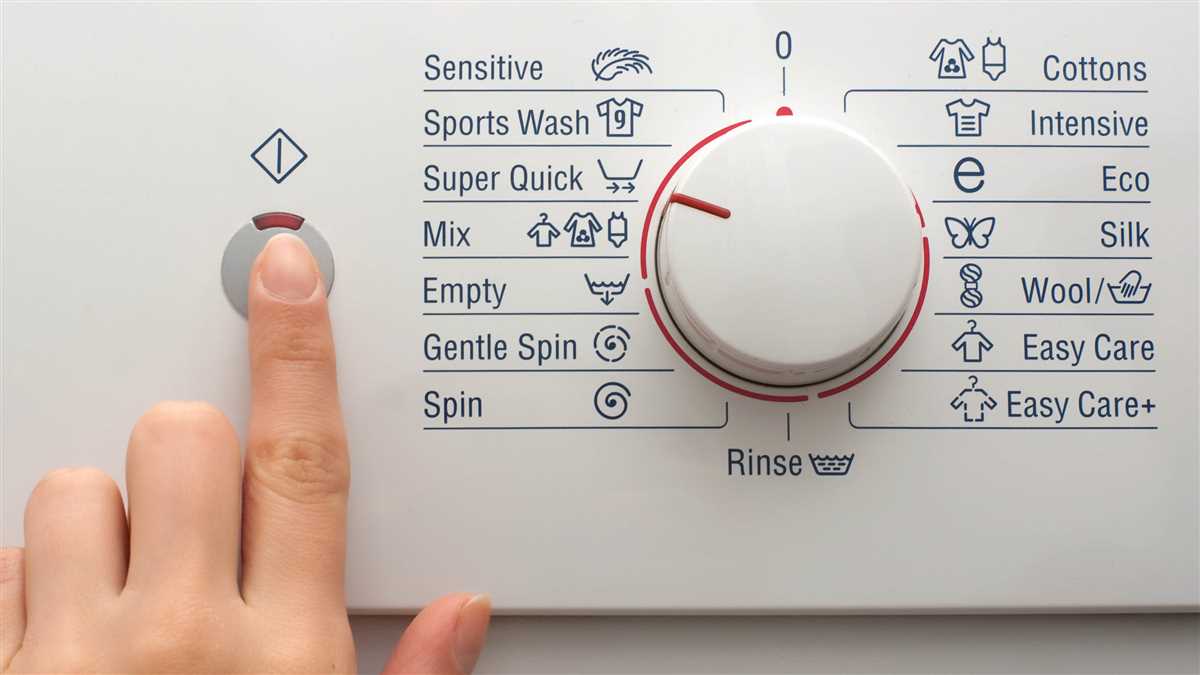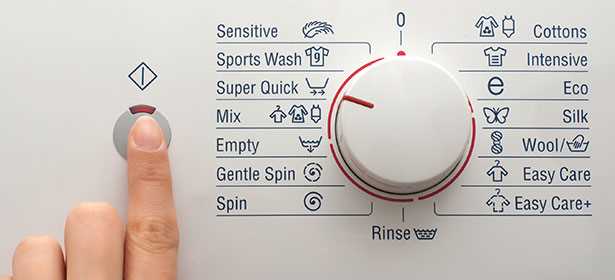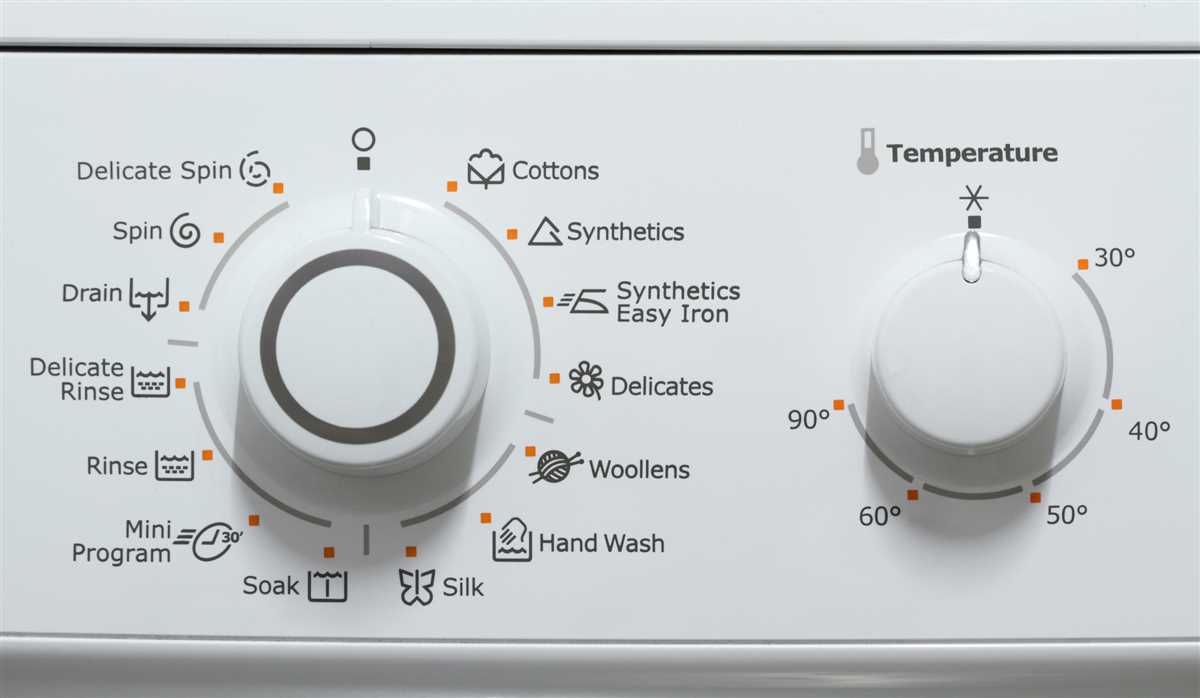




Washing machines have become an essential appliance in every household, making the task of doing laundry much easier and more efficient. However, with the wide range of washing machine programs and cycles available, it can be overwhelming to figure out which ones to use for specific types of fabrics and stains. In this complete guide, we will explore the various washing machine programs and cycles, and help you understand when and how to use them.
One of the most common programs found in washing machines is the “Normal” or “Regular” cycle. This cycle is designed for everyday laundry, such as t-shirts, jeans, and underwear. It typically uses a medium amount of water, agitates the clothes to remove dirt and stains, and spins at a moderate speed to remove excess water. The Normal cycle is a great choice for most of your regular laundry needs.
For delicate fabrics, such as silk or lace, it is best to use the “Delicate” or “Gentle” cycle. This cycle uses less water and a slower spin speed to protect the delicate fibers. It is important to note that you should always check the care label on your clothes to ensure they are safe to be washed on the Delicate cycle.
When dealing with heavily soiled items or tough stains, the “Heavy Duty” or “Stain Removal” cycle is your best bet. This cycle uses a longer wash time, higher water temperature, and extra agitation to tackle stubborn stains and deeply embedded dirt. It is important to pretreat stains before using this cycle for maximum effectiveness.
Other specialized cycles you may find in your washing machine include “Quick Wash” for lightly soiled items that need a faster wash, “Bulky” for larger items like comforters or blankets, and “Rinse and Spin” for items that only need to be rinsed and spun dry. It is always a good idea to consult your washing machine’s manual to fully understand its different programs and cycles.
Tip: To ensure the longevity of your clothes and washing machine, remember to separate your laundry by color and fabric type, and never overload the machine.
By understanding the different washing machine programs and cycles, you can optimize your laundry routine and keep your clothes looking their best. Whether you are dealing with delicate fabrics, tough stains, or simply need a quick wash, there is a program or cycle that suits your needs. With proper care and knowledge, your washing machine can be a powerful tool in maintaining clean and fresh laundry.
Overview of Washing Machine Programs
Modern washing machines come with a variety of programs and cycles that cater to different types of fabrics and washing needs. Understanding these programs can help you optimize your washing machine’s performance and ensure that your clothes are cleaned effectively without causing any damage.
Types of Programs

1. Normal or Standard Program: This is the most commonly used program and is suitable for everyday laundry. It uses a medium-temperature wash cycle and a high-speed spin to efficiently clean and dry your clothes.
2. Delicate Program: This program is designed for delicate fabrics such as silk, wool, and lace. It uses a gentle wash cycle with low agitation and a slow spin speed to prevent damage to the delicate fibers.
3. Heavy Duty Program: If you have heavily soiled clothes or items that require deep cleaning, the heavy-duty program is the best choice. It uses a higher temperature and a longer wash cycle to effectively remove tough stains and dirt.
4. Quick Wash Program: This program is ideal for lightly soiled garments that need a quick refresh. It uses a shorter wash cycle and lower water level to save time and energy.
5. Sportswear Program: If you frequently work out or play sports, this program is perfect for cleaning your activewear. It uses a lower temperature and a gentle wash cycle to protect the fabric’s elasticity and prolong its lifespan.
6. Allergen Program: This program is designed to remove allergens such as dust mites, pollen, and pet dander from your clothes. It uses higher temperatures and additional rinse cycles to ensure a thorough clean.
Additional Options
In addition to the different programs, washing machines also offer various options that can enhance your washing experience:
- Temperature Control: Allows you to adjust the temperature of the wash cycle based on the fabric type and level of dirtiness.
- Spin Speed Control: Lets you adjust the spin speed, which affects the moisture left in your clothes after the wash cycle.
- Delay Start: Allows you to set a delay in the start of the washing cycle, so you can have your clothes ready when you need them.
- Extra Rinse: Adds an additional rinse cycle to remove any remaining detergent residue from your clothes.
- Pre-Wash: This option agitates the clothes before the main wash cycle, which can help to loosen and remove heavy stains.
It’s important to read the user manual and labels on your clothing to understand which program and options are best suited for each garment. By selecting the appropriate program and using the right detergent, you can ensure that your clothes are cleaned effectively and last longer.
| Program | Temperature | Spin Speed | Duration |
|---|---|---|---|
| Normal/Standard | Medium | High | 60-90 minutes |
| Delicate | Low | Slow | 30-45 minutes |
| Heavy Duty | High | High | 90-120 minutes |
| Quick Wash | Low | Medium | 15-30 minutes |
| Sportswear | Low | Slow | 45-60 minutes |
| Allergen | High | High | 120-150 minutes |
Different Types of Washing Programs
Washing machines come with a variety of different programs, each designed for a specific type of clothing or fabric. The different programs offer different settings for water temperature, spin speed, and cycle duration to ensure optimal cleaning while minimizing damage to delicate garments. Here are some of the most common types of washing programs:
- Normal/Regular Cycle: This is the default program for everyday laundry. It uses a moderate agitation and spin speed, along with a regular amount of detergent, to clean most common fabrics such as cotton, linen, and synthetic blends.
- Delicate Cycle: The delicate cycle is designed for fragile fabrics that require gentle handling, such as silk, lace, and cashmere. It uses a slower agitation and spin speed to avoid excessive stretching or snagging.
- Hand Wash/Delicate Program: This program is specifically for garments that are labeled as “hand wash only”. It replicates the gentle hand washing motion to clean delicate items without causing damage.
- Wool Cycle: The wool cycle is designed for washing woolen garments. It uses a low agitation and spin speed to prevent felting and shrinkage.
- Sports/Active Wear Cycle: This program is tailored for washing sports clothing, such as workout leggings and athletic shirts, which often require a thorough cleaning to remove sweat and odors. It typically includes a higher agitation and spin speed to ensure a deep clean.
- Quick Wash Cycle: The quick wash cycle is designed for lightly soiled garments that need a fast wash. It uses a shorter cycle duration and higher agitation to provide a quick cleaning solution.
- Heavy Duty Cycle: The heavy-duty cycle is designed for heavily soiled items, such as bed linens and work clothes. It uses a longer cycle duration, increased water temperature, and a higher agitation to effectively remove tough stains and dirt.
It’s important to read the instruction manual of your washing machine to understand the available programs and their recommended usage. Choosing the right program for your laundry can help extend the lifespan of your clothes and ensure they are cleaned effectively.
Choosing the Right Program for Your Laundry
Understanding Different Washing Machine Programs

Modern washing machines come with a variety of programs that are designed to cater to different types of fabrics and cleaning needs. Understanding these programs is essential to choose the right one for your laundry.
Quick Wash Program
The Quick Wash program is perfect for lightly soiled clothes that need to be cleaned quickly. It typically runs for a shorter duration, using less water and detergent compared to regular programs.
Delicate Program
The Delicate program is specifically designed for fragile and easily damaged fabrics such as silk, lace, or wool. It has a gentler washing and spin cycle to protect these materials from excessive agitation.
Normal/Regular Program
The Normal or Regular program is suitable for everyday laundry items like cotton clothes and bed sheets. It provides a comprehensive cleaning cycle using moderate water and energy levels.
Heavy Duty Program
The Heavy Duty program is ideal for heavily soiled and durable items like jeans, towels, and bedding. It involves longer washing and spinning times, higher water temperatures, and stronger agitation to remove tough stains and dirt.
Hand Wash Program

The Hand Wash program simulates the gentle washing process used when washing delicate items by hand. It is great for clothes that require extra care, such as lingerie, hosiery, or clothes with embellishments.
Choosing the Right Program

When choosing the program for your laundry, consider the following factors:
- Fabric Type: Determine the fabric type and choose a program that is suitable for it. Delicate fabrics require a gentle program, while tougher fabrics can withstand a heavy-duty program.
- Level of Soiling: Assess how dirty your clothes are. For lightly soiled items, a quick wash program may be sufficient, whereas heavily soiled items would require a heavy-duty program.
- Energy and Water Efficiency: If you want to save energy and water, opt for programs that have energy-saving features or lower temperature settings.
- Special Features: Some washing machines offer additional programs like antibacterial wash, allergy wash, or sportswear wash. Consider these features if you have specific cleaning requirements.
Consult the User Manual
Always refer to the user manual of your washing machine for detailed information about each program. The manual will provide specific instructions on which program to use for different types of laundry.
Conclusion
Choosing the right program for your laundry is crucial to ensure optimal cleaning results and garment care. By understanding the different programs available and considering factors such as fabric type, level of soiling, energy efficiency, and special features, you can make an informed decision and enjoy clean and fresh laundry every time.
Popular Washing Machine Cycles Explained
1. Normal Cycle

The normal cycle is the default and most commonly used cycle for regular everyday laundry. It is designed to clean your clothes using a standard wash and rinse process.
2. Heavy-Duty Cycle
The heavy-duty cycle is ideal for heavily soiled clothes, such as workwear or sports gear. It uses a combination of longer agitation and higher water temperatures to remove tough stains and dirt.
3. Delicates Cycle
The delicates cycle is specifically designed for delicate fabrics such as silk, lace, or lingerie. It uses a gentle wash action, lower water temperatures, and slower spin speeds to prevent damage to delicate items.
4. Quick Wash Cycle
The quick wash cycle is designed for lightly soiled clothes that need to be cleaned in a hurry. It uses shorter wash and rinse times, and may not include a spin cycle, depending on the machine.
5. Wool Cycle

The wool cycle is specially designed for washing wool and wool-blend items. It uses gentle agitation, low water temperatures, and reduced spinning to prevent shrinking and felting of the fabric.
6. Allergen Cycle
The allergen cycle is designed to remove allergens such as dust mites, pollen, and pet dander from your clothes. It uses higher water temperatures and extra rinses to thoroughly clean and remove allergens.
7. Sanitize Cycle
The sanitize cycle is designed to kill bacteria and germs on your clothes. It uses high water temperatures and extended wash times to ensure a deep clean and eliminate any harmful microorganisms.
8. Pre-Soak Cycle
The pre-soak cycle allows you to soak your clothes before starting the wash cycle. It helps to loosen and remove tough stains and dirt by allowing the detergent to penetrate the fabric before agitation begins.
9. Rinse and Spin Cycle
The rinse and spin cycle is used to rinse out any remaining detergent or fabric softener from your clothes. It can also be used to spin out excess water from hand-washed or pre-soaked items.
10. Self-Clean Cycle
The self-clean cycle is used to clean the washing machine drum and remove any build-up of residue or odors. It is recommended to run this cycle regularly to keep the machine functioning efficiently.
11. Intensive Wash Cycle

The intensive wash cycle is designed for heavily soiled items that require extra cleaning power. It uses longer wash and rinse times, as well as higher water temperatures and increased agitation.
12. Eco-Friendly Cycle
The eco-friendly cycle is designed to minimize water and energy usage, making it a more environmentally friendly option. It typically uses shorter wash and rinse times and lower water temperatures.
13. Sports Cycle

The sports cycle is designed specifically for cleaning sports clothing and gear. It uses a combination of high agitation, higher water temperatures, and extended rinse times to remove sweat, dirt, and odors from athletic wear.
14. Baby Care Cycle
The baby care cycle is designed to clean and sanitize baby clothes and diapers. It uses high heat and extra rinses to remove any traces of detergent or bacteria, ensuring that the items are safe for sensitive skin.
15. Bedding Cycle
The bedding cycle is designed for cleaning larger items such as comforters, blankets, and pillows. It uses increased agitation and longer wash and rinse times to ensure a thorough cleaning of these bulky items.
| Washing Machine Cycle | Description |
|---|---|
| Normal Cycle | The default cycle for regular everyday laundry. |
| Heavy-Duty Cycle | Ideal for heavily soiled clothes. |
| Delicates Cycle | Specially designed for delicate fabrics. |
| Quick Wash Cycle | Cleans lightly soiled clothes in a hurry. |
| Wool Cycle | For washing wool and wool-blend items. |
| Allergen Cycle | Removes allergens from your clothes. |
| Sanitize Cycle | Kills bacteria and germs on your clothes. |
| Pre-Soak Cycle | Allows you to soak clothes before washing. |
| Rinse and Spin Cycle | Rinses out remaining detergent and spins out water. |
| Self-Clean Cycle | Cleans the washing machine drum. |
| Intensive Wash Cycle | For heavily soiled items. |
| Eco-Friendly Cycle | Minimizes water and energy usage. |
| Sports Cycle | Cleans sports clothing and gear. |
| Baby Care Cycle | Cleans and sanitizes baby clothes and diapers. |
| Bedding Cycle | Cleans larger items such as comforters and blankets. |
Regular/Normal Cycle

The regular/normal cycle is the basic and most commonly used cycle for the everyday laundry needs. It provides a thorough wash with a normal or moderate wash time and spin speed. This cycle is suitable for washing most types of everyday clothing, including shirts, pants, socks, and undergarments.
The regular/normal cycle usually consists of the following steps:
- Pre-wash: The machine fills with water and agitates the laundry to loosen any dirt or stains.
- Main wash: Detergent is added, and the machine agitates the laundry at a higher speed to thoroughly clean the clothes.
- Rinse: The machine drains the dirty water and refills with clean water to rinse away any remaining detergent and dirt.
- Final spin: The machine spins the clothes at a high speed to extract as much water as possible, reducing drying time.
The regular/normal cycle is often adjustable in terms of temperature and spin speed to accommodate different fabric types and soil levels. It is recommended to follow the garment care labels to ensure the best results and prevent damage to delicate items.
This cycle is typically the default setting on most washing machines and provides a balance between cleaning performance and time efficiency. However, for heavily soiled or delicate items, it may be necessary to select a different cycle or use supplemental features such as pre-soak or extra rinse to achieve the desired cleanliness.
Delicate/Gentle Cycle
The delicate/gentle cycle is designed specifically for washing delicate fabrics and items that require extra care. This cycle uses a slower spin speed and gentle agitation to minimize the risk of damage to delicate items.
When to use the Delicate/Gentle Cycle?
- Delicate fabrics such as silk, lace, and chiffon
- Hand-wash only items
- Items with intricate embroidery or beading
- Bras, lingerie, and other delicate underwear
- Delicate baby clothes
How does the Delicate/Gentle Cycle work?
The delicate/gentle cycle typically has a shorter wash time and a slower spin speed. This cycle uses less agitation to minimize the risk of stretching, tearing, or damaging delicate fabrics. The lower water temperature also helps to protect the integrity of delicate items.
Tips for using the Delicate/Gentle Cycle
- Always check the care label on your clothing or fabric to confirm if it is safe for the delicate/gentle cycle.
- Place delicate items in a mesh laundry bag to provide extra protection during the wash cycle.
- Use a gentle detergent specifically designed for delicate fabrics.
- Avoid overloading the washing machine, as this can cause excessive friction and potential damage to delicate items.
- Remove items promptly from the washing machine after the cycle is complete to prevent wrinkling or additional damage.
Conclusion
The delicate/gentle cycle is a useful option for washing delicate fabrics and items that require extra care. By using this cycle, you can ensure that your delicate items remain in good condition and retain their original quality for longer periods of time.
Heavy Duty Cycle
The Heavy Duty cycle is designed for heavily soiled or large loads that require a more intensive wash. It is perfect for items such as blankets, bedding, and heavily stained clothes.
This cycle typically runs at a higher temperature and uses more water and detergent compared to other cycles. The increased agitation and longer duration help remove tough stains and dirt.
When using the Heavy Duty cycle, it is important to check the manufacturer’s instructions for the maximum load size, as overloaded machines can cause excessive wear and tear.
Here are some key points to keep in mind when using the Heavy Duty cycle:
- Sort your laundry according to fabric type and colour before starting the cycle.
- Pre-treat any particularly tough stains before loading them into the machine.
- Use the appropriate amount of detergent recommended for heavy soils.
- Avoid overloading the machine, as this can affect the cleaning performance.
- Consider using an extra rinse cycle to ensure all detergent is rinsed out.
Overall, the Heavy Duty cycle is a powerful option for tackling tough stains and heavily soiled items. With the right care and proper usage, it can help keep your clothes and textiles clean and fresh.
FAQ
How many different washing machine programs are there?
There are several different washing machine programs, typically ranging from 6 to 14. The exact number and names of the programs can vary depending on the model and brand of the washing machine.
What is the purpose of the “Quick Wash” program?
The “Quick Wash” program is designed to wash clothes quickly, usually in around 30 minutes. This program is useful when you need to freshen up lightly soiled clothes in a short amount of time.
What is the difference between the “Cotton” and “Synthetic” programs?
The “Cotton” program is intended for washing durable fabrics, such as cotton, linen, and denim. It uses higher water temperature and longer duration to ensure thorough cleaning. The “Synthetic” program, on the other hand, is designed for delicate fabrics like polyester, nylon, and acrylic. It uses lower temperature and gentler agitation to protect the fabrics.
Can I adjust the temperature and spin speed of a washing machine program?
Yes, most modern washing machines allow you to adjust the temperature and spin speed of each program. This gives you flexibility to customize the wash according to the fabric type and your personal preferences. However, some entry-level models may have limited options for temperature and spin speed adjustments.
What is the purpose of the “Rinse & Spin” program?
The “Rinse & Spin” program is used to rinse and spin clothes without any detergent. It is commonly used when you want to remove leftover detergent or if you want to refresh clothes that have been sitting in the washing machine for a while. This program typically has a shorter duration compared to regular wash programs.
What are the different types of washing machine programs and cycles?
The different types of washing machine programs and cycles include normal, heavy duty, delicate, quick wash, wool, hand wash, and many more. Each program is designed to meet specific washing needs and requirements.
Can I wash all types of clothes in a washing machine?
While most clothes can be washed in a washing machine, some delicate items like silk or wool may require special care. It is important to check the care labels on your clothes before washing them in a machine. If in doubt, it is best to hand wash or take them to a professional cleaner.















